Related Research Articles

Camouflage is the use of any combination of materials, coloration, or illumination for concealment, either by making animals or objects hard to see, or by disguising them as something else. Examples include the leopard's spotted coat, the battledress of a modern soldier, and the leaf-mimic katydid's wings. A third approach, motion dazzle, confuses the observer with a conspicuous pattern, making the object visible but momentarily harder to locate, as well as making general aiming easier. The majority of camouflage methods aim for crypsis, often through a general resemblance to the background, high contrast disruptive coloration, eliminating shadow, and countershading. In the open ocean, where there is no background, the principal methods of camouflage are transparency, silvering, and countershading, while the ability to produce light is among other things used for counter-illumination on the undersides of cephalopods such as squid. Some animals, such as chameleons and octopuses, are capable of actively changing their skin pattern and colours, whether for camouflage or for signalling. It is possible that some plants use camouflage to evade being eaten by herbivores.

Abbott Handerson Thayer was an American artist, naturalist, and teacher. As a painter of portraits, figures, animals, and landscapes, he enjoyed a certain prominence during his lifetime, and his paintings are represented in major American art collections. He is perhaps best known for his 'angel' paintings, some of which use his children as models.

In ecology, crypsis is the ability of an animal or a plant to avoid observation or detection by other animals. It may be a predation strategy or an antipredator adaptation. Methods include camouflage, nocturnality, subterranean lifestyle and mimicry. Crypsis can involve visual, olfactory or auditory concealment. When it is visual, the term cryptic coloration, effectively a synonym for animal camouflage, is sometimes used, but many different methods of camouflage are employed by animals or plants.
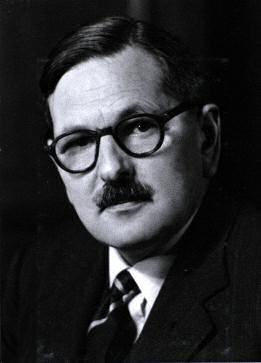
Hugh Bamford Cott was a British zoologist, an authority on both natural and military camouflage, and a scientific illustrator and photographer. Many of his field studies took place in Africa, where he was especially interested in the Nile crocodile, the evolution of pattern and colour in animals. During the Second World War, Cott worked as a camouflage expert for the British Army and helped to influence War Office policy on camouflage. His book Adaptive Coloration in Animals (1940), popular among serving soldiers, was the major textbook on camouflage in zoology of the twentieth century. After the war, he became a Fellow of Selwyn College, Cambridge. As a Fellow of the Zoological Society of London, he undertook expeditions to Africa and the Amazon to collect specimens, mainly reptiles and amphibians.
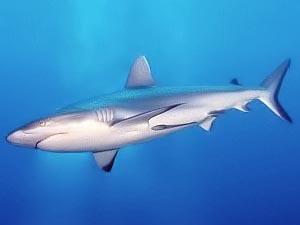
Countershading, or Thayer's law, is a method of camouflage in which an animal's coloration is darker on the top or upper side and lighter on the underside of the body. This pattern is found in many species of mammals, reptiles, birds, fish, and insects, both in predators and in prey.

Nature photography is a wide range of photography taken outdoors and devoted to displaying natural elements such as landscapes, wildlife, plants, and close-ups of natural scenes and textures. Nature photography tends to put a stronger emphasis on the aesthetic value of the photo than other photography genres, such as photojournalism and documentary photography.

Animal colouration is the general appearance of an animal resulting from the reflection or emission of light from its surfaces. Some animals are brightly coloured, while others are hard to see. In some species, such as the peafowl, the male has strong patterns, conspicuous colours and is iridescent, while the female is far less visible.

A camera trap is a camera that is automatically triggered by motion in its vicinity, like the presence of an animal or a human being. It is typically equipped with a motion sensor – usually a passive infrared (PIR) sensor or an active infrared (AIR) sensor using an infrared light beam.
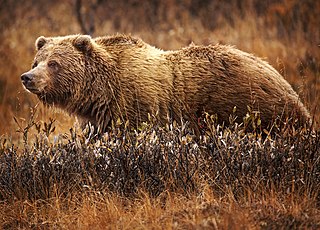
Fur is a thick growth of hair that covers the skin of almost all mammals. It consists of a combination of the oily outer guard hairs and thick underfur beneath. The guard hair keeps moisture from reaching the skin; the underfur acts as an insulating blanket that keeps the animal warm.

Underwater camouflage is the set of methods of achieving crypsis—avoidance of observation—that allows otherwise visible aquatic organisms to remain unnoticed by other organisms such as predators or prey.

Disruptive coloration is a form of camouflage that works by breaking up the outlines of an animal, soldier or military vehicle with a strongly contrasting pattern. It is often combined with other methods of crypsis including background colour matching and countershading; special cases are coincident disruptive coloration and the disruptive eye mask seen in some fishes, amphibians, and reptiles. It appears paradoxical as a way of not being seen, since disruption of outlines depends on high contrast, so the patches of colour are themselves conspicuous.
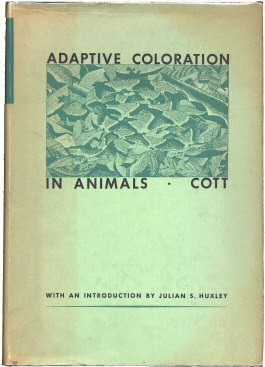
Adaptive Coloration in Animals is a 500-page textbook about camouflage, warning coloration and mimicry by the Cambridge zoologist Hugh Cott, first published during the Second World War in 1940; the book sold widely and made him famous.

Animal Coloration, or in full Animal Coloration: An Account of the Principal Facts and Theories Relating to the Colours and Markings of Animals, is a book by the English zoologist Frank Evers Beddard, published by Swan Sonnenschein in 1892. It formed part of the ongoing debate amongst zoologists about the relevance of Charles Darwin's theory of natural selection to the observed appearance, structure, and behaviour of animals, and vice versa.
Deception in animals is the transmission of misinformation by one animal to another, of the same or different species, in a way that propagates beliefs that are not true.

Snow camouflage is the use of a coloration or pattern for effective camouflage in winter, often combined with a different summer camouflage. Summer patterns are typically disruptively patterned combinations of shades of browns and greys, up to black, while winter patterns are dominated by white to match snowy landscapes.

Animal coloration provided important early evidence for evolution by natural selection, at a time when little direct evidence was available. Three major functions of coloration were discovered in the second half of the 19th century, and subsequently used as evidence of selection: camouflage ; mimicry, both Batesian and Müllerian; and aposematism.
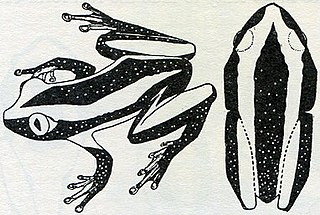
Coincident disruptive coloration or coincident disruptive patterns are patterns of disruptive coloration in animals that go beyond the usual camouflage function of breaking up the continuity of an animal's shape, to join up parts of the body that are separate. This is seen in extreme form in frogs such as Afrixalus fornasini where the camouflage pattern extends across the body, head, and all four limbs, making the animal look quite unlike a frog when at rest with the limbs tucked in.
Timothy M. Caro is a British evolutionary ecologist known for his work on conservation biology, animal behaviour, anti-predator defences in animals, and the function of zebra stripes. He is the author of several textbooks on these subjects.
Peter John Herring is an English marine biologist known for his work on the coloration, camouflage and bioluminescence of animals in the deep sea, and for the textbook The Biology of the Deep Ocean.
References
- ↑ "Martin Stevens". Work With Data. Archived from the original on 18 September 2023. Retrieved 18 September 2023.
- ↑ "Professor Martin Stevens". University of Exeter . Archived from the original on 14 September 2023. Retrieved 14 September 2023.
- ↑ "Martin Stevens profile". The Conversation . April 2014. Archived from the original on 16 September 2023. Retrieved 16 September 2023.
- ↑ "About the author Martin Stevens". British Ornithologists’ Union . Archived from the original on 16 September 2023. Retrieved 16 September 2023.
- ↑ "Research into equine vision leads to trial of new fence and hurdle design to further improve safety in jump racing". University of Exeter . Archived from the original on 17 September 2023. Retrieved 17 September 2023.
- ↑ "Racing looks through the eyes of the horse to help deliver improved safety at all British jump courses". British Horseracing Authority . Archived from the original on 17 September 2023. Retrieved 17 September 2023.
- ↑ Britton, Bianca (23 October 2018). "New research on horse eyesight could improve racecourse safety". CNN . Archived from the original on 17 September 2023. Retrieved 17 September 2023.
- ↑ Stevens, Martin (2008). "Animal camouflage: current issues and new perspectives". Philosophical Transactions of the Royal Society of London. Series B, Biological Sciences. U.S. Department of Health and Human Services. 364 (1516): 423–427. doi:10.1098/rstb.2008.0217. PMC 2674078 . PMID 18990674.
- ↑ Stevens, Martin; Párraga, C. Alejandro; Cuthill, Innes C; Partridge, Julian C; Troscianko, Tom S (2007). "Using digital photography to study animal coloration". Biological Journal of the Linnean Society. Wiley. 90 (2): 211–237. doi: 10.1111/j.1095-8312.2007.00725.x .
- ↑ Cuthill, Innes C; Stevens, Martin; Sheppard, Jenna; Maddocks, Tracey; Párraga, C. Alejandro; Troscianko, Tom S (2005). "Disruptive coloration and background pattern matching". Nature . Springer Nature. 434 (7029): 72–74. Bibcode:2005Natur.434...72C. doi:10.1038/nature03312. PMID 15744301. S2CID 4421702. Archived from the original on 15 September 2023. Retrieved 15 September 2023.
- ↑ "Martin Stevens". Google Scholar. Retrieved 12 January 2018.
- 1 2 "Q&A with Martin Stevens (Sensory Ecology)". Forever Cornwall. 23 August 2022. Archived from the original on 14 September 2023. Retrieved 14 September 2023.
- 1 2 3 "Cream of the camera crop: Cornwall's wildlife photographers". Wild Cornwall Magazine. Cornwall Wildlife Trust. 12 November 2021. Archived from the original on 15 September 2023. Retrieved 15 September 2023.
- ↑ "UPY British Waters Compact - Winner Martin Stevens". Underwater Photographer of the Year. Archived from the original on 14 September 2023. Retrieved 14 September 2023.
- ↑ Corbett, Claire. "Creative Conversations with Martin Stevens Sensory ecology". Cornish Holiday Cottages. Archived from the original on 15 September 2023. Retrieved 15 September 2023.
- 1 2 Sullivan, Matthew. "Photographer of the Week – Martin Stevens". DivePhotoGuide.com. Archived from the original on 15 September 2023. Retrieved 15 September 2023.
- ↑ "Sensory Ecology". Viridis magazine. 14 October 2020. Archived from the original on 15 September 2023. Retrieved 15 September 2023.
- ↑ Stevens, Martin. "How to Use GoPros for Underwater Photography". NatureTTL. Archived from the original on 15 September 2023. Retrieved 15 September 2023.
- ↑ Radford, Benjamin; Frazier, Kendrick (January 2017). "Cheats and Deceits: How Animals and Plants Exploit and Mislead" (PDF). Skeptical Inquirer . Center for Inquiry. p. 60. Archived from the original (PDF) on 11 September 2023. Retrieved 11 September 2023.
- ↑ Forbes, Peter (25 February 2016). "Cheats and Deceits: How Animals and Plants Exploit and Mislead by Martin Stevens, book review". The Independent . Archived from the original on 17 September 2023. Retrieved 17 September 2023.
- ↑ "Exeter researcher writes book for Attenborough series". University of Exeter . Archived from the original on 17 September 2023. Retrieved 17 September 2023.
- ↑ Simon Ings. "Secret Worlds review: Immerse yourself in amazing animal senses". New Scientist . Archived from the original on 16 September 2023. Retrieved 16 September 2023.
- ↑ "ZSL Scientific Medal Winners" (PDF). Zoological Society of London . Archived from the original (PDF) on 14 September 2023. Retrieved 14 September 2023.
- ↑ "Prestigious medal honour for University of Exeter sensory ecology and behaviour expert". University of Exeter . Archived from the original on 14 September 2023. Retrieved 14 September 2023.
- ↑ "College notices". Cambridge University Reporter. Cambridge University. Archived from the original on 14 September 2023. Retrieved 14 September 2023.
- ↑ "College notices". Cambridge University Reporter. Cambridge University. Archived from the original on 14 September 2023. Retrieved 14 September 2023.
